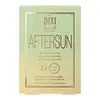What's inside
What's inside
 Key Ingredients
Key Ingredients

 Benefits
Benefits

 Concerns
Concerns

No concerns
 Ingredients Side-by-side
Ingredients Side-by-side

Water
Skin ConditioningPropylene Glycol
HumectantGlycerin
HumectantAlcohol
AntimicrobialDipotassium Glycyrrhizate
HumectantGlyceryl Acrylate/Acrylic Acid Copolymer
HumectantHamamelis Virginiana Leaf Water
AstringentHydrogenated Starch Hydrolysate
HumectantHydroxyacetophenone
AntioxidantHydroxyethylcellulose
Emulsion StabilisingLimonene
PerfumingMannose
HumectantP-Anisic Acid
MaskingPEG-40 Hydrogenated Castor Oil
EmulsifyingPhenoxyethanol
PreservativePotassium Hydroxide
BufferingPotassium Sorbate
PreservativePunica Granatum Fruit Extract
AntioxidantPvm/Ma Copolymer
Emulsion StabilisingSodium Benzoate
MaskingSodium Hyaluronate
HumectantSorbic Acid
PreservativeXanthan Gum
EmulsifyingParfum
MaskingWater, Propylene Glycol, Glycerin, Alcohol, Dipotassium Glycyrrhizate, Glyceryl Acrylate/Acrylic Acid Copolymer, Hamamelis Virginiana Leaf Water, Hydrogenated Starch Hydrolysate, Hydroxyacetophenone, Hydroxyethylcellulose, Limonene, Mannose, P-Anisic Acid, PEG-40 Hydrogenated Castor Oil, Phenoxyethanol, Potassium Hydroxide, Potassium Sorbate, Punica Granatum Fruit Extract, Pvm/Ma Copolymer, Sodium Benzoate, Sodium Hyaluronate, Sorbic Acid, Xanthan Gum, Parfum
Water
Skin ConditioningGlycerin
HumectantBetaine
HumectantNiacinamide
SmoothingPanthenol
Skin ConditioningTremella Fuciformis Extract
HumectantAllantoin
Skin ConditioningAscorbic Acid
AntioxidantCucumis Sativus Fruit Extract
EmollientChamomilla Recutita Extract
Skin ConditioningAloe Barbadensis Leaf Extract
EmollientPhellinus Linteus Extract
Skin ConditioningChamomilla Recutita Flower Extract
MaskingArctium Lappa Root Extract
Skin ConditioningMadecassoside
AntioxidantCeramide NP
Skin Conditioning1,2-Hexanediol
Skin ConditioningDipotassium Glycyrrhizate
HumectantOctyldodecanol
EmollientTrehalose
HumectantHydrogenated Lecithin
EmulsifyingEthyl Hexanediol
SolventHydroxyethylcellulose
Emulsion StabilisingCaprylyl Glycol
EmollientPhenoxyethanol
PreservativeWater, Glycerin, Betaine, Niacinamide, Panthenol, Tremella Fuciformis Extract, Allantoin, Ascorbic Acid, Cucumis Sativus Fruit Extract, Chamomilla Recutita Extract, Aloe Barbadensis Leaf Extract, Phellinus Linteus Extract, Chamomilla Recutita Flower Extract, Arctium Lappa Root Extract, Madecassoside, Ceramide NP, 1,2-Hexanediol, Dipotassium Glycyrrhizate, Octyldodecanol, Trehalose, Hydrogenated Lecithin, Ethyl Hexanediol, Hydroxyethylcellulose, Caprylyl Glycol, Phenoxyethanol
 Reviews
Reviews

Ingredients Explained
These ingredients are found in both products.
Ingredients higher up in an ingredient list are typically present in a larger amount.
Dipotassium Glycyrrhizate comes from licorice root.
Extracts of licorice have demonstrated to have antibacterial, anti‐inflammatory, antiviral, antioxidant properties.
One component, glabridin, has extra potent antioxidant and soothing properties. It has also been found to block pigmentation from UVB rays in guinea pigs.
Licorice Root also contains a flavonoid. Flavonoids are a natural substance from in plants. Flavonoids also have antioxidant properties.
Another component, glycyrrhizin, has been found to have anti-inflammatory and antimicrobial benefits. This may make licorice root extract effective at treating acne. However, more research is needed to support this.
Liquiritin is one of the flavone compounds found in licorice. It has been found to help lighten skin by preventing tyrosinase from reacting with tyrosine. When the two react, protein is converted to melanin. Melanin is the substance in your body that gives your features pigmentation.
Licorice root is native to Southern Europe and Asia. It has been used in traditional Chinese medicine to help with respiratory issues.
Learn more about Dipotassium GlycyrrhizateGlycerin is already naturally found in your skin. It helps moisturize and protect your skin.
A study from 2016 found glycerin to be more effective as a humectant than AHAs and hyaluronic acid.
As a humectant, it helps the skin stay hydrated by pulling moisture to your skin. The low molecular weight of glycerin allows it to pull moisture into the deeper layers of your skin.
Hydrated skin improves your skin barrier; Your skin barrier helps protect against irritants and bacteria.
Glycerin has also been found to have antimicrobial and antiviral properties. Due to these properties, glycerin is often used in wound and burn treatments.
In cosmetics, glycerin is usually derived from plants such as soybean or palm. However, it can also be sourced from animals, such as tallow or animal fat.
This ingredient is organic, colorless, odorless, and non-toxic.
Glycerin is the name for this ingredient in American English. British English uses Glycerol/Glycerine.
Learn more about GlycerinHydroxyethylcellulose is used to improve the texture of products. It is created from a chemical reaction involving ethylene oxide and alkali-cellulose. Cellulose is a sugar found in plant cell walls and help give plants structure.
This ingredient helps stabilize products by preventing ingredients from separating. It can also help thicken the texture of a product.
This ingredient can also be found in pill medicines to help our bodies digest other ingredients.
Learn more about HydroxyethylcellulosePhenoxyethanol is a preservative that has germicide, antimicrobial, and aromatic properties. Studies show that phenoxyethanol can prevent microbial growth. By itself, it has a scent that is similar to that of a rose.
It's often used in formulations along with Caprylyl Glycol to preserve the shelf life of products.
Water. It's the most common cosmetic ingredient of all. You'll usually see it at the top of ingredient lists, meaning that it makes up the largest part of the product.
So why is it so popular? Water most often acts as a solvent - this means that it helps dissolve other ingredients into the formulation.
You'll also recognize water as that liquid we all need to stay alive. If you see this, drink a glass of water. Stay hydrated!
Learn more about Water